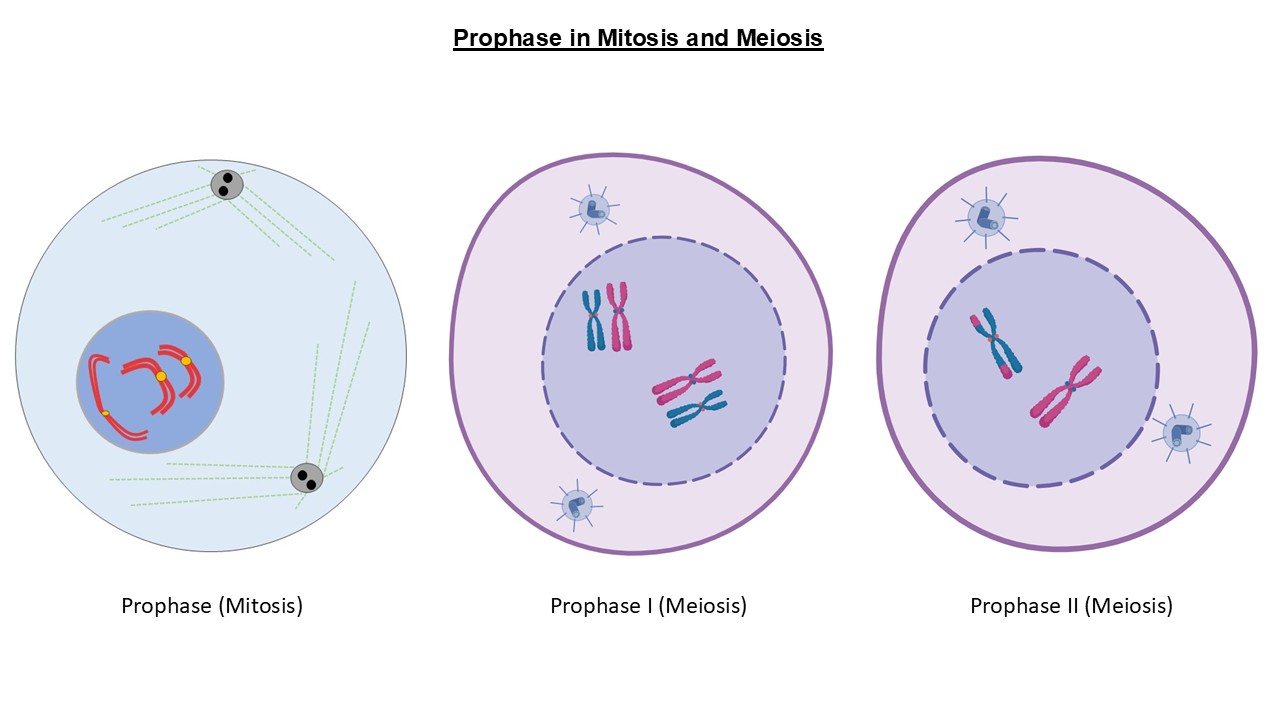The first stage of mitosis and meiosis, two crucial cellular division processes that support an organism’s growth, repair, and reproduction, is known as prophase.The specifics of what transpires and why differ depending on the cell’s activity in either mitosis or meiosis, even though chromosomal condensation and spindle construction are shared by all kinds of prophase. In this article, we examine the biological significance and cellular functions of prophase in mitosis and prophase I and II in meiosis.
Prophase in Mitosis
Overview
Mitosis is the mechanism by which a eukaryotic cell divides to form two genetically equivalent daughter cells, each with the same number of chromosomes as the parent. Prophase is the initial and one of the most active phases of mitosis.
Most Important Activities during Mitotic Prophase
- Chromatin Condensation: Chromosomes condense to form visible thread-like structures, each made up of two sister chromatids that are attached to a centromere.
- Mitotic Spindle Formation: Microtubules start to establish the mitotic spindle, radiating from centrosomes (or spindle poles).
- Centrosome Migration: The two centrosomes migrate to opposite ends of the cell.
- Nuclear Envelope Breakdown: The nuclear membrane starts to break down so that spindle fibers can interact with chromosomes.
- Nucleolus Disappears: The nucleolus becomes less prominent or disappears completely.
Role in Mitosis
Mitotic prophase ensures that the genetic content is properly arranged and available for orderly division. It lays the foundation for metaphase alignment and proper segregation of sister chromatids to each daughter cell in a manner that preserves genomic integrity during growth and repair.
Prophase I in Meiosis
Meiosis is the process of cell division that results in four haploid cells from a single diploid cell. These cells are responsible for sexual reproduction and give rise to gametes such as sperm and ova. Prophase I is specific to meiosis and much more complicated than its mitotic equivalent.
The Five Substages of Prophase I
- Leptotene: Chromosomes start to condense and look like thin threads.
- Zygotene: Synapsis of the homologous chromosomes, pairing closely to give bivalents.
- Pachytene: Non-sister chromatids cross over, bringing in genetic recombination.
- Diplotene: Synaptonemal complex breaks; chromosomes begin separating but are still attached at chiasmata.
- Diakinesis: Condensation is complete; nuclear envelope disintegrates; spindle fibers attach to kinetochores.
Function in Meiosis I
Prophase I brings about genetic diversity through recombination and orients homologous chromosomes for later segregation. This ensures gametes possess dissimilar genetic material, which makes the population variable and ever-evolving as far as fitness is concerned.
Prophase II in Meiosis
Chromatid Preparation for Division. Once Meiosis I has been completed, the cells proceed to enter Meiosis II, which is similar to a mitotic division. Prophase II takes place in each of the two resulting haploid cells after Meiosis I.
Major Events in Prophase II
- Chromosome Re-condensation: Chromosomes re-condense if they become decondensed slightly in interphase.
- Formation of New Spindle Apparatus: Spindle fibers develop in each haploid cell.
- Breakdown of Nuclear Envelope: If re-established, the envelope disassembles to allow spindle attachment.
- Positioning of Centrosome: Centrosomes move to opposite ends to prepare for division.
Function in Meiosis II
Prophase II readies the cell for equational division of the sister chromatids. No recombination is done as in Prophase I. It makes sure that each gamete gets one set of chromosomes to keep the cell haploid.
Comparative Table: Prophase in Mitosis vs. Meiosis
| Feature | Mitotic Prophase | Prophase I (Meiosis I) | Prophase II (Meiosis II) |
|---|---|---|---|
| Cell Division Type | Mitosis | Meiosis I | Meiosis II |
| Objective | Growth, repair | Genetic diversity and reduction of chromosome number | Separation of sister chromatids |
| Chromosome State | Duplicated (sister chromatids) | Homologous chromosomes pair and recombine | Duplicated (sister chromatids) |
| Crossing Over | No | Yes | No |
| Chromosome Pairing | No pairing | Synapsis of homologous chromosomes | No pairing |
| Genetic Outcome | Identical daughter cells | Genetically varied haploid cells | Further reduction to individual chromatids |
| Spindle Formation | Yes | Yes | Yes |
| Nuclear Envelope Status | Breaks down | Breaks down during diakinesis | Breaks down (if reformed) |
Last Modified:






